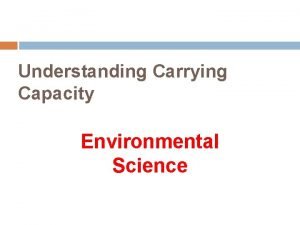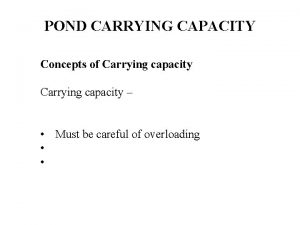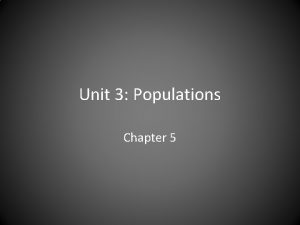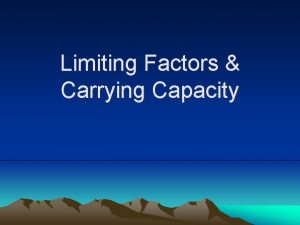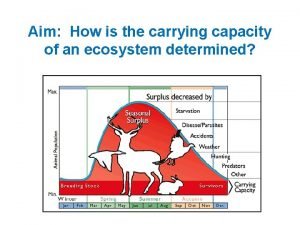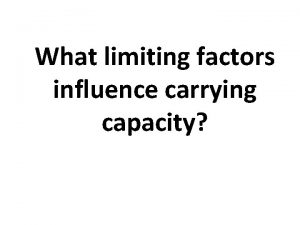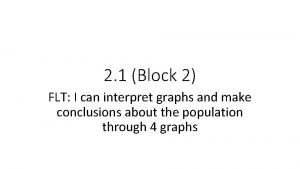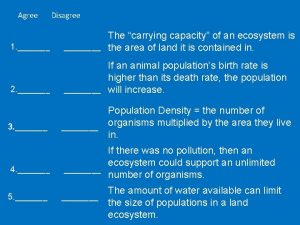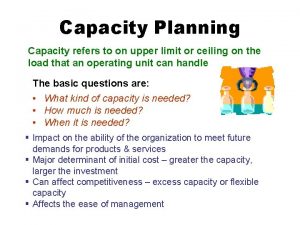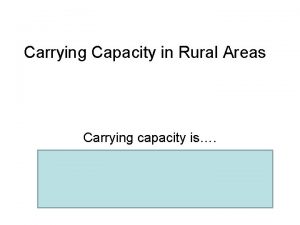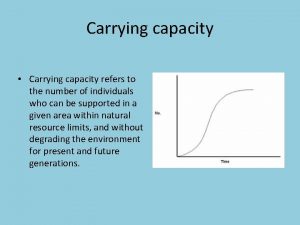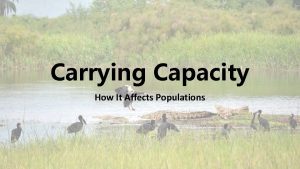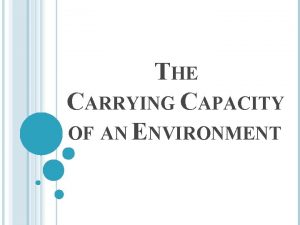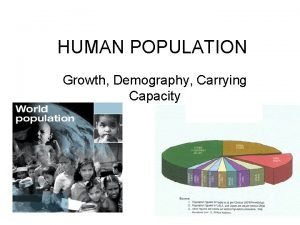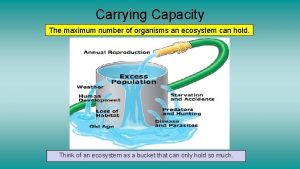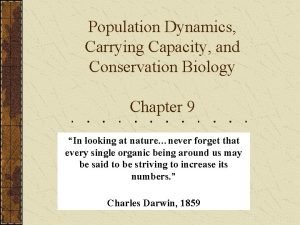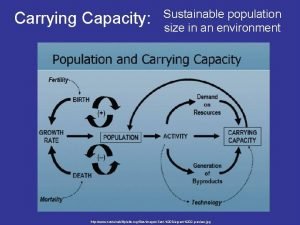What is Carrying Capacity Is the maximum population





































- Slides: 37

What is Carrying Capacity? • Is the maximum population a habitat can support indefinitely • Population exceeds it, for long periods, degrades its environment and reduces future carrying capacity

The Biosphere

What is the Biosphere? • Combined portions of the planet in which all of life exists, including land, water and atmosphere • Extend from 8 -km above Earth’s surface to 11 -km below the surface of the ocean.

The Structure of the Earth’s Atmosphere * Chemical Composition * Vertical Layers * Coriolis Force * Hadley Cells

Current Composition

Atmospheric Composition today



The Troposphere • The surface layer up to about 30, 000 ft • Heated from below, by ground having absorbed solar energy • Temperature highest near the ground, and falls all the way up to about 30, 000 ft • It is the densest part of the atmosphere and contains about 85% of atmosphere’s mass.

The Stratosphere • • • Heated mostly by absorbing UV light from the sun by O 3 (ozone), breaking it apart into O 2 + atomic oxygen. When they recombine to make ozone, you get energy release and heating Ozone in the stratosphere absorbs ultraviolet radiation, warming it up in the mid-upper parts of the layer. The reason for the increase in temperatures in the stratosphere with height relates to the wavelength of the incoming solar energy. At higher altitudes in the stratosphere, ozone very efficiently absorbs UV at wavelengths between 200 and 350 nanometers. At lower altitudes in the stratosphere, ozone absorbs UV at wavelengths between 44 and 80 nanometers but much less efficiently. This results in a rate of warming in the lower stratosphere that is less than the rate higher in the stratosphere, causing the temperature to increase with height. Therefore is hottest at the highest layers, cooler down where it contacts the cold upper troposphere At the bottom of the stratosphere, most UV has already been absorbed higher up, so further heating is very reduced, hence the temperature vs height is the opposite from the Troposphere This temperature inversion means no convection, no weather.


The Mesosphere • Above the Stratosphere, the mass of atmosphere is only 0. 1% of the total, and the density is too low for ozone chemistry to heat the atmosphere • Hence, we get the normal trend we saw in the troposphere re-asserting itself – lower temperature with lower pressure and lower altitude. • This layer is 30 -50 miles above the ground.

The Ionosphere (= Thermosphere) • Above mesosphere; density so low the Space Shuttle and ISS orbit here, with little drag • Temperature can be very high; 4, 000 F. But no significant heat because density is so low. • Heated by ionization by UV from the sun, and the solar wind.


Hadley, Ferrel, Polar Cells • The Coriolis deflection sets the major constraint on how many cells the atmosphere of a planet divides into. Coriolis force is stronger for more rapid rotation. It is the size of the planet and speed of rotation (and a lesser extent, the depth of the atmosphere) which determines how many of these. Earth’s atmosphere divides into 3 cells. • For Jupiter, it is many more, as it is 12 times larger in diameter and yet has a day only 12 hrs long. Coriolis Force is very strong.

The Coriolis Effect

The Hadley Cell • Solar heating at the equator is strongest, causing rising convective air which is pushed north and south at the tropopause (troposphere/stratosphere boundary). • At ~30 deg latitude it has deflected enough by the Coriolis force. Here, it meets air moving down from the north (Ferrel Cell air) and both meet and descend, warming and drying • The return of the air, now a surface wind, to the equator is called the “trade winds”.


Mid-latitudes - The Ferrel Cell • Convective rising air near 60 deg latitude arrives at the tropopause, moves (in part) to the south, deflecting by Coriolis to the west, till it meets the northerly moving air from the tropical Hadley cell, forcing both to descend • These are the “Horse Latitudes” at +-30 deg (30 -38) latitude. Descending air dries. Deserts here (e. g. Sahara, Mojave/Sonora) • Northerly moving surface winds deflected east - “the Westerlies” carrying heat from the lower latitudes to higher mid latitudes • The primary circulation on Earth is driven by the equatorially heated Hadley Cell, and the polar cooled Polar Cell. The Ferrel cell is a weaker intermediate zone, in which weather systems move through driven by the polar jet stream (boundary between Ferrel and Polar cell, at the tropopause) and the tropical jet stream (boundary between Ferrel and Hadley cells, at the tropopause).


The Polar Cell • Easiest of the cells to understand – rising air from the 60 degree latitude area in part moves north to the pole, where it’s cold enough to densify, converge with other northerly winds from all longitudes, and descends. • This makes a “desert” at the north and south poles.


Key Points – Structure of Earth’s Atmosphere • 78% Nitrogen which is fairly inert. 21% oxygen, 400 ppm CO 2 • Troposphere – heated from sun-warmed ground, T falls with height • Stratosphere, heated from above by UV absorbed by ozone; T rises with height • Troposphere can have convection = weather; stratosphere cannot • Mesosphere; where meteors burn up. Ionosphere, heated by solar wind, aurorae. Top two layers almost no mass, little influence on climate • Hadley/Ferrel/Polar cells. Their general circulation • Ferrel cell is weakest; having neither a strong heat source nor sink • Coriolis force stronger with more rapid rotation and larger planet size, making more cells • Jet streams – tropical and polar – boundaries between the cells at the tropopause

• Local Wind Patterns – Due to: • The relationship between air temperature and air density. • Relationship between air pressure and the movement of air. – Upward and downward movement of air leads to: • The upward movement has a lifting effect on the surface that creates areas of low pressure • The downward movement of air has a piling up effect resulting in areas of high pressure.

• A model of the relationships between differential heating, the movement of air, and pressure difference in a convective cell. Cool air pushes the less dense, warm air upward, reducing the surface pressure. As the uplifted air cools and becomes more dense, it sinks, increasing the surface pressure.

• Atmospheric Pressure – The atmosphere exerts pressure on the Earth that decreases with increasing altitude • This is due to the fact that with increasing altitude, there is a decrease in the column of gases above the Earth’s surface – Hydrostatics considers the pressure that is exerted by a fluid that is at rest. • Using this as a frame of reference the atmospheric pressure is viewed as a result of the mass of the column of gases above the Earth. – Using a molecular frame of reference, the atmospheric pressure is viewed as a result of the kinetic energy of molecules and the force with which they strike an object. – Atmospheric pressure is actually a result of the

• At greater altitudes, the same volume contains fewer molecules of the gases that make up the air. This means that the density of air decreases with increasing altitude.

• The mercury barometer measures the atmospheric pressure from the balance between the pressure exerted by the weight of the mercury in a tube and the pressure exerted by the atmosphere. As atmospheric pressure increases and decreases, the mercury rises and falls. This sketch shows the average height of the column at sea level.

• Water and the Atmosphere • Evaporation and Condensation – Humidity • The amount of water vapor in the air • Absolute humidity is a measure of the amount of water vapor present at a given time. • Relative humidity is a measure of the amount of water vapor present in the air relative to the amount that the air could hold at that temperature.

• The maximum amount of water vapor that can be in the air at different temperatures. The amount of water vapor in the air at a particular temperature is called the absolute humidity.

– The Rate of Evaporation depends on: • surface area of the exposed liquid. • Air and water temperature • Relative humidity – The Rate of Condensation depends on: • relative humidity • Kinetic energy of the gas molecules in the air.

• Evaporation and condensation are occurring all the time. If the number of molecules leaving the liquid state exceeds the number returning, the water is evaporating. If the number of molecules returning to the liquid state exceeds the number leaving, the water vapor is condensing. If both rates are equal, the air is saturated; that is, the relative humidity is 100 percent.

– Dew point temperature • Temperature at which the relative humidity and the absolute humidity are the same (saturated air) • Dew begins to accumulate on surfaces. • Form on C nights: – Clear – Calm – Cool

Frost is the coating of ice that may form in humid and cold condition. It forms when temperature of a solid surface (soil) in the open cools to below freezing point of water. • Fans like this one are used to mix the warmer, upper layers of air with the cooling air in the orchard on nights when frost is likely to form.

– Condensation nuclei • Gives condensing moisture in the atmosphere something to condense on. • Necessary for the production of moisture in the atmosphere (rain, snow). • As condensation continues, eventually there will be a point where enough water molecules have condensed on the nuclei that it can no longer remain air borne. • It will then fall in the form of rain, snow, etc…

• This figure compares the size of the condensation nuclei to the size of typical condensation droplets. Note that 1 micron is 1/1, 000 mm.

A B C D E F • (A)Cumulus clouds. (B) Stratus and stratocumulus. Note the small stratocumulus clouds forming from increased convection over each of the three small islands. (C) An aerial view between the patchy cumulus clouds below and the cirrus and cirrostratus above (the patches on the ground are clear-cut forests). (D) Altocumulus. (E) A rain shower at the base of a cumulonimbus. (F) Stratocumulus.
 Relationship between population and carrying capacity
Relationship between population and carrying capacity Carrying capacity population
Carrying capacity population Carrying capacity graph
Carrying capacity graph Carrying capacity of pond
Carrying capacity of pond Carrying capacity
Carrying capacity Boxns wagon carrying capacity
Boxns wagon carrying capacity Demographic transition model ap human geography
Demographic transition model ap human geography Whats carrying capacity
Whats carrying capacity Thomas malthus carrying capacity
Thomas malthus carrying capacity Can less than 150 minnows live in this lake
Can less than 150 minnows live in this lake Specific limiting factors
Specific limiting factors Carrying capacity exponential growth
Carrying capacity exponential growth Calculus equations
Calculus equations Exponential growth and carrying capacity
Exponential growth and carrying capacity Carrying capacity example
Carrying capacity example Carrying capacity
Carrying capacity Carrying capacity
Carrying capacity The information carrying capacity of hologram is
The information carrying capacity of hologram is Maximum likelihood vs maximum parsimony
Maximum likelihood vs maximum parsimony Absolute max vs local max
Absolute max vs local max Maximum likelihood vs maximum parsimony
Maximum likelihood vs maximum parsimony Theoretical maximum capacity
Theoretical maximum capacity The term capacity refers to the maximum quantity
The term capacity refers to the maximum quantity Maximum capacity refers to the upper limit of:
Maximum capacity refers to the upper limit of: Maximum capacity refers to the upper limit of
Maximum capacity refers to the upper limit of Design capacity and effective capacity examples
Design capacity and effective capacity examples Section 1 population dynamics
Section 1 population dynamics Population ecology section 1 population dynamics
Population ecology section 1 population dynamics Chapter 4 section 1 population dynamics
Chapter 4 section 1 population dynamics Chapter 4 population ecology worksheet answer key
Chapter 4 population ecology worksheet answer key Công của trọng lực
Công của trọng lực V. c c
V. c c Tỉ lệ cơ thể trẻ em
Tỉ lệ cơ thể trẻ em Thơ thất ngôn tứ tuyệt đường luật
Thơ thất ngôn tứ tuyệt đường luật Hổ sinh sản vào mùa nào
Hổ sinh sản vào mùa nào đại từ thay thế
đại từ thay thế Diễn thế sinh thái là
Diễn thế sinh thái là Phản ứng thế ankan
Phản ứng thế ankan


